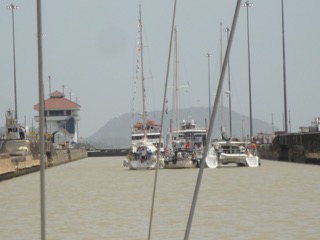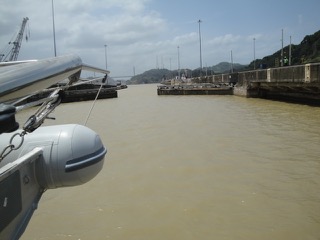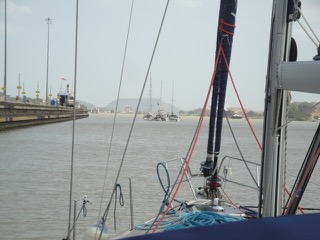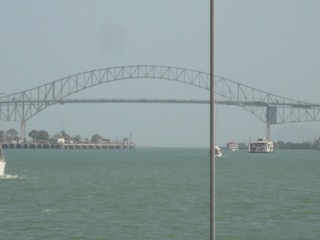Salt Water Crocodiles and The Panama Canal 08:54:43N 079:31.53W

|
Salt Water Crocodiles and The Panama Canal We arrived in the San Blas islands about 70 miles South of the entrance to the Panama Canal on Saturday 28 February. On Sunday the weather was not good and we guessed that the customs and immigration office on the tiny island of Porvenir would be closed. Only a few people live on Porvenir but it does have an airstrip, the only one in the whole archipelago. The guide book advises not anchoring in line with the runway, they were right, the threshold of the runway was right on the beach, the runway not very long, with reefs and the sea at the other end. The pilots of the small planes have to get it right! We checked in on Monday, a lot of paperwork, visiting different officers in the same building, immigration, customs, the marine office, the police check in and the San Blas Islands community check in. It was not cheap, $100 each for the visa, $193 for the Panamanian cruising permit, $60 for the local community, so $453 US dollars, worse off, we were in Panama! The San Blas Islands are an autonomous region within the state of Panama, home to the Kuna Indians who up until maybe 30- 40 years ago, due to the remoteness of the islands and their strong beliefs in their tribal identity, led an existence cut off from the rest of the world and lived the traditional lives they have done for thousands of years. Some Kuna Indians we saw living on the remoter islands still do, but on the larger islands, a small but probably increasing number of the residents have solar panels charging batteries to run TV’s with satellite dishes and mobile phones. The majority however still live a very basic life in their palm frond roofed shacks, with traditional woven matting walls and are very poor. The arrival of an ever-increasing number of yachts, small cruise ships and tourist boats is changing their lifestyle. The islands are idyllic, white sands with palm trees; clear pastel blue waters, a real tropical paradise. The throwaway modern world intrudes even here with countless plastic bottles and shoes being washed up on the otherwise pristine shores. We cruised the islands and anchored off an island called Banedup. We
swam and snorkelled, went for a walk around the island along the white sand
beaches and wading in the sea when mangroves came down to the shoreline.
Wonderful. The
next day a large salt-water crocodile appeared from the same mangroves exactly where
we had wandered into the sea! We decided against further waterborne adventures
in this area and stayed on board; playing backgammon seemed a safer option! An overnight passage took us to the port of Colon and Shelter Bay Marina at the entrance to The Panama Canal. The advice to foreigners is not to go into the city of Colon without a taxi dropping and collecting you from every point. It is a dangerous place with foreigners being prime targets for muggings, robberies and worse. We decided to give the aptly named city of Colon a miss! Shelter Bay Marina was fine and they organised a shopping bus to the out of town supermarket. Caroline did the biggest shop ever, stocking up for the next six months. The supermarket provides a van delivery service back to the marina. Michael was most upset to miss the mammoth shopping expedition and 5 hours in the supermarket, he was forced to stay on the yacht because the local Iridium agent came and replaced the satellite phone and internet system antenna. Our parcel arrived from Italy, by DHL, with the DC motor brushes for the water maker. They had been stuck in Panamanian Customs for a week but $17 got them on their way to us. Caroline collected the parcel from the marina office and we were both pleased we could now get the water maker repaired again. We eagerly opened the box and then to our dismay, they had sent the wrong brushes! They were smaller and the copper wire and springs were too short. We were both quite down about this, and wrote an appropriately worded e-mail to the company the next day after we had calmed down. Michael managed to use part of the old brushes and part of the incorrect brushes and by soldering the copper wire managed to make a temporary repair. The water maker was producing water again. We used the services of an agent called Erik to handle all the documentation for transiting the canal. Well worth it, everything was sorted out on board, no trips into Colon, no paying into the bank and then taking the receipt back to the canal authorities. No buffer payment to cover a deposit, in fact Erik had a portable credit card machine with him on board, we provided copies of our passports and ships papers entered our PIN number into his machine and the job was done. An attractive Panamanian girl turned up to measure our yacht and as they take into account the anchor sticking out the front to the dingy hanging off the back, we were 56 feet overall so came well into the 50-80 foot price band. Within a week our date to start the canal transit was arranged for Friday 13th March. We
are not superstitious! We
had heard stories of it taking much longer to arrange but by using Erik,
everything had gone smoothly. He arranged the hire of 4 extra long lines, 8
extra strong fenders and provided two Panamanian guys to come on board and act
as line handlers. With Australian friends Phil and Pam from the yacht Maranatha
on board to help we were set to go. It is a requirement that in addition to the
skipper, you have 4 line handlers and a professional Panama Canal advisor on
board. So with Caroline and Phil also acting as line handlers we set off to
anchor just outside the entrance in an area known as The Flats. Our advisor / pilot joined us about 5.30pm
and we set off for the first set of locks at Gatun. The advisor’s name was Roy
and he was a great guy, giving good advice, was very knowledgeable and knew
what he was doing. He had been doing this for 30 years, so we felt very
comfortable with him. The ‘locks’ in The Panama Canal are massive and due to the enormous amount of water coming in or going out, the flow creates a huge amount of turbulence. For a small vessel, this can create problems, hence the line handlers to keep the yacht stable. As it was we were rafted up to an historical motor yacht The Islamorada. It was a very old boat, that Roy informed us, was once owned by Al Capone and then by Clarke Gable. The
Gatun locks are three chambers going up into a large artificially created
fresh- water lake. On arrival in the lake we tied up to a massive mooring buoy
rafted up with a catamaran next to us and three other yachts rafted up on the
other side of the buoy. The advisor was collected by a pilot boat and the two
Panamanian line handlers and our Australian friends slept on board. Part of the
deal with the line handlers is to provide food, which Caroline took care of
with lasagne, salad and garlic bread followed by a great trifle. The next morning another advisor came on board and we motored across the lake for 26 miles following a very clearly defined channel. A lot of the Panama Canal is actually a channel across the middle of a freshwater lake. We came to the three ‘down’ locks, waived at the webcam on the last Mirraflores lock and that was it, we motored under ‘The Bridge of The Americas’ and were into The Pacific. A dream for a long time had actually happened, and after a boat man collected the line handlers, our friends, the lines and fenders, we were soon anchored on the other side of Panama at the edge of the worlds largest ocean. Any excuse, time to celebrate again! La Playita anchorage near Balboa, Panama 08:54:43N 079:31.53W  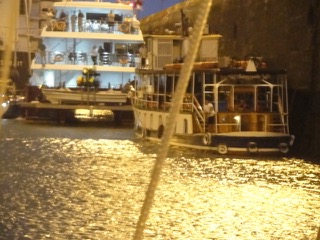 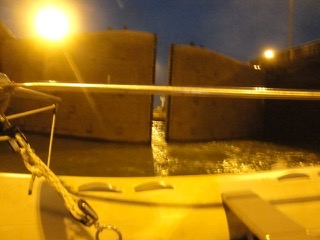
|

